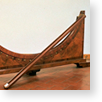
Throughout his scientific career, Galileo conducted research into the nature and laws of motion. This quest culminated in the formulation of a totally new dynamics based on mathematical reasoning and ingenious experiments, which he set out in Discorsi e dimostrazioni matematiche [Mathematical discourses and demonstrations] (Leyden 1638). In this seminal book, Galileo replaced the Aristotelian concept of motion with a vision based on new principles: acceleration is a natural property that remains constant over time; the conservation and composition of motion; the parabolic path of projectiles; the infinite force of an impact; and so on. For Galileo, the radical reform of Aristotelian dynamics also paved the way for the definitive assertion of the Copernican vision.
Apparatus for experiments on pendulums
Inv. 982
Maker unknown, second half 18th cent.
Apparatus to demonstrate the isochronism of falls along a spiral
Inv. 976
Maker unknown, first half 18th cent.
Apparatus to demonstrate the parabolic trajectory of projectiles
Inv. 968
Maker unknown, late 18th cent.
Brachistochronous fall
Inv. 966
Francesco Spighi, Florence, second half 18th cent.
Inclined plane
Inv. 1041
Maker unknown, Florence, early 19th cent.














